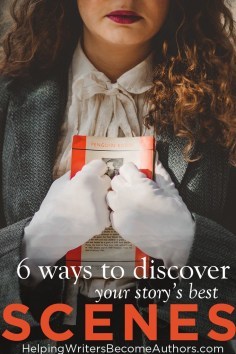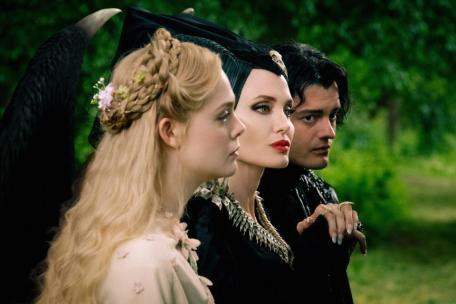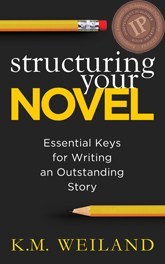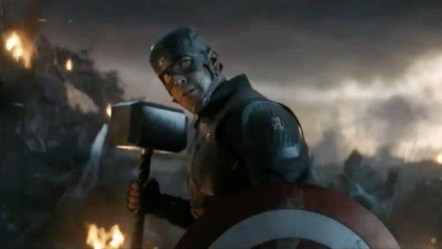How to Know Which Parts of Your Story Readers Will Like Best (It Isn’t Always What You Think)
 You want readers to like your story. You want to give them something to love on every single page. But it’s so much easier said than done. How can you know—really know—which parts of your story readers will like and which will have them yawning and skipping ahead?
You want readers to like your story. You want to give them something to love on every single page. But it’s so much easier said than done. How can you know—really know—which parts of your story readers will like and which will have them yawning and skipping ahead?
So many stories, in all mediums, hit the market with blazing optimism from their creators. Audiences are going to love this! We’ve checked all the boxes!! We’re so excited to share something we’re so sure is going to make you so happy!!!
The optimism isn’t always well-founded. Just watch behind-the-scenes interviews on would-be blockbusters, which were intended as the first in a series only to fall flat at the box office and never be heard from again. Beforehand, directors, producers, and actors might have gushed about how certain they were audiences would geek out over their choices for the film—only to have their enthusiasm met with a big green splat on Rotten Tomatoes. Clearly, they misjudged those parts of the story they thought audiences would particularly like.
Novels don’t usually dive-bomb so obviously or spectacularly, but I can certainly think of a few sequels that failed to live up to their glorious predecessors. Mostly, this is because the authors made clunker decisions that, pretty obviously, were intended to be just the opposite.
So what are you to do? Maybe throw a bunch of stuff at the wall and hope enough sticks to keep readers happy? Or maybe just write the blithering book to the best of your ability and hope it all works out for the best?
Naturally, the latter option is the way to go. But it doesn’t have to be a blind path into the unknown. There are ways to figure out which parts of a story are mostly likely to entertain readers and which are not. And the key words here are “most likely,” because if there’s one thing you can be sure of in this business, it’s that art is subjective.
6 Ways to Figure Out Which Parts of Your Story Readers Will Like Best
Subconsciously, readers are going to judge every single one of your scenes and file each in one of three categories:
Entertaining
Tolerable
Boring
Very few stories manage the brilliance necessary to land every single scene in the Entertaining Category. The good news is that you can still create a story readers like even with a handful of Tolerable scenes and maybe even a (very) small percentage of Boring scenes.
The bad news is that the higher your Tolerable count rises, the more the book as a whole will lean toward Boring. Even if readers finish it, they’re not likely to remember it. And, of course, if the count on the Boring scenes crosses a certain invisible threshold (which is a little different for every reader or viewer), the story is bye-bye.
You can perform a rather sobering exercise by listing all your scenes and ruthlessly judging which falls into which category. Every scene that ends up in the Tolerable or Boring Categories needs some help.
And how do you help them? Here are six ways to judge whether a scene contains the stuff readers love—or the stuff they actually don’t.
1. The Best Part of Your Story Is… Your Characters
So I admit this post is kinda inspired by Maleficent: Mistress of Evil, which left me pretty meh. It’s not totally a fair example, since the film is exactly what it’s intended to be. But for my money it could have been a lot better. It just needed more of its characters—especially its most interesting characters.
Elle was fine, Pfeiffer showed admirable dental work in chewing through the scenery. But is this Maleficent’s show or not? Like so many stories these days, the protagonist appeared in a scant percentage of the actual running time. (I find it a little ironic that in a film supposed to be about the original villain of the Sleeping Beauty story, most of the story and screentime went to the new villain.) The only scenes in the movie I would chuck squarely into the Entertaining bucket were the few moments early on when Maleficent’s sidekick coached her in smiling and then later when Maleficent grudgingly tried to charm the future in-laws. After that… not too much interesting character work going on.

The movie falls into one of the most common pitfalls I see in stories that try really hard to be Entertaining without quite making it: it splits up it’s most interesting characters. For roughly 60% of the story, Maleficent doesn’t interact with any characters except the Dark Fey—whom she mostly just observes. When [SPOILER] the guy she did talk to dies, however crucially, the relationship feels barely developed, almost meaningless, especially in comparison to the preexisting characters back home with whom she could have interacted with so much more entertainment value. [END SPOILER]
This is the single most important trick for genuinely entertaining readers.
1. You have to write great characters—people with whom the audience will emotionally invest and who will then act with genuine spontaneity and organic energy.
2. You’ve got to put all your best characters in the same room. One awesome character monologuing to a bunch of redshirts (or, worse, musing in solitude) is never going to deliver the same amount of goods as two (or more!) awesome characters impacting each other’s plot progressions.
3. Don’t skimp on the character interaction just to squeeze in other stuff. Other stuff is important. But it is not—it is never—as important as character development.
2. The Best Part of Your Story Isn’t (Necessarily) Genre Beats
Usually, the stories that try really hard to please readers only to fail are those that place too much faith in the importance of genre beats.
Now, don’t get me wrong. Genre beats are important and can be wildly entertaining. Romance readers want the kiss. Superhero fans want the Big Boss battle in the end. Paying nothing but lip service to important genre tropes can make it seem as if you’re phoning in the entire story. But overdoing them, especially at the expense of developing other aspects of the story (*cough*characters*cough*), can create an ironically flat experience even for die-hard fans of the genre.
To my eye, there seems to be a lot of confusion about exactly what to do with genre beats these days. Writers know readers have seen certain beats so often, they’ve become clichéd. So they go meta on the clichés by pointing them out (but, don’t miss, still including them). A super-obvious example is calling out the villain monologue. The subversion of the trope felt fresh and funny when Syndrome did it back in 2004, but not so much anymore.

Truly, the only way to hit genre beats in a deeply satisfying and entertaining way is to go old-fashioned—do it how it was done in the very beginning, back before a particular beat ever became something so obvious as a beat, much less a trope. And what is this old-fashioned way? Write it organically into your story. Make it a crucial and emotionally-important part of the plot-character-theme trifecta. If you can’t be fresh (and, please, be fresh), then at least be so honest with your story that it hurts.
3. The Best Part of Your Story Is That Sweet Spot Between What Readers Have Seen Before and What They Haven’t

What are genre beats? For that matter, what’s plot structure and character arc? Although many writers initially see these beats as something to be arbitrarily added to a story (the “secret sauce,” if you will), these beats are instead an emergent of time-tested archetypal patterns. “Genre beats” are a thing not because readers “like” them, but because readers resonate with them.
Understanding story theory and studying the archetypal patterns in narrative will give you a foundation for writing a type of story that will reliably grab people’s hearts. But as any reader or viewer will immediately tell you, this does not mean they want to see the same thing over and over.

Genre fatigue happens when the same storyform is being told too often in the same way. In a romance, we want to see the leads end up together. But that doesn’t mean we want the 100th rendition of Marry Christmas: A Holiday Happily Ever After. People fall in love every day. It’s the same archetypal story. But to those involved in it, each story is brand new and deeply important—and deserves to be told with honesty and freshness. Hit your genre beats, but do it in a way that is integral to the story you’re trying to tell (a story no one’s ever told before, right?) and with the truth of your own unique experience.
4. The Best Part of Your Story Is (and Isn’t) What You Like Best
Until your story is out there for readers to irrevocably judge (aka, until it’s too late), the only person who can give you a line on whether your story has enough of the “good stuff” is… you.
You know you’re on the right track with any scene you emotionally or viscerally respond to. You know you’re on the right track if you’re writing the kind of scene you would get on your knees and beg your favorite author or director to make for you. (And, note, this doesn’t just mean ripping off the scenes you went nuts over in somebody else’s story.) What’s your favorite scene in your story so far? That scene might well be the most entertaining scene in your whole book (and if it’s not, it should be).
Be careful, however, to distinguish between the scenes you love because they hit you in the gut and the scenes you love just because you think they’re really, really, clever. If you’re realistically acknowledging that you skillfully executed a scene, that’s one thing. But if you’re geeking out because you’re just sure readers will bow to your genius, you might want to double-check your objectivity.
5. The Best Part of Your Story Isn’t the Part That Doesn’t Work
Spoiler alert: if the writing’s bad in any given scene, that’s probably not going to be the scene your readers fall in love with.
In short, as G.R.R. Martin has told us (in a way that seems kinda prescient now):
Ideas are cheap. I have more ideas now than I could ever write up. To my mind, it’s the execution that is all-important.
Funny characters, shiny plot beats, and original ideas won’t save a story that doesn’t come together holistically. Here’s a very short, very incomplete list of the mistakes that can blind readers to even your most entertaining scenes:
Plot holes (“It was fun, but… it made. no. sense.”)
Authorial condescension (“Yes, yes, the overdone symbolism and on-the-nose dialogue made the thematic message so much more powerful.”)
Authorial self-indulgence (“Ten chapters of worldbuilding. There must be a test at the end of the book. There’s a test, isn’t there?”)
Wasted time (“We get it. She’s training. Again.”)
Boring info (“Ah, my old friend—backstory info dump. What would we ever do without you?”)
6. The Best Part of Your Story Is the Foreshadowing
This one almost is a secret sauce. This is because foreshadowing is one of the most powerful tools in a writer’s bag for evoking emotion.
Yep, you heard right.
Foreshadowing, done right, can knock your book out of the park. And I guarantee you’ve got some missed opportunities waiting for you in your story right now. I say this because I see these missed opportunities all the time in published stories.
The key is to remember there are two halves to proper foreshadowing: the setup and the payoff.
It goes without saying that if you pique reader curiosity by setting up a big juicy clue early on, then you must pay that off later in the story. Otherwise, it’s one of those plot holes we took issue with in the previous section.
Most writers know this and are careful to payoff early clues. What is easier to overlook is the opportunity presented by any big event in your story’s second half—especially the Climax. And I do mean anything. Even the smallest reveal or plot turn deep in the story can be transformed into an emotionally resonant moment by planting a little foreshadowing early on (don’t believe me? go watch Endgame again).

Examine every scene in the second half of your story and make a list of any and all revelations and plot turns. Can you create foreshadowing opportunities for at least some of these early on? Callbacks such as these create the effect of depth, meaning, and thematic resonance (plus, it makes it look like you really know what you’re doing). Skillful foreshadowing has the ability to take a Tolerable scene (even a Boring one, in a few cases) and transform it into an Entertaining and even unforgettable moment in your story.
***
Ultimately, the parts of your story readers will like best are probably the parts that made you want to write the story in the first place. Look for those scenes, figure out why they are so personally powerful to you, then leverage them for all they’re worth. Readers won’t be able to look away, and they’ll close your book happily wishing you’d given them more of everything rather than grumpily wishing you’d just given them more of the good stuff.
Wordplayers, tell me your opinions! What do you think are the parts of your story readers will like best? Tell me in the comments!
http://www.podtrac.com/pts/redirect.mp3/kmweiland.com/podcast/best-parts-of-your-story.mp3
Click the “Play” button to Listen to Audio Version (or subscribe to the Helping Writers Become Authors podcast in iTunes).
The post How to Know Which Parts of Your Story Readers Will Like Best (It Isn’t Always What You Think) appeared first on Helping Writers Become Authors.



